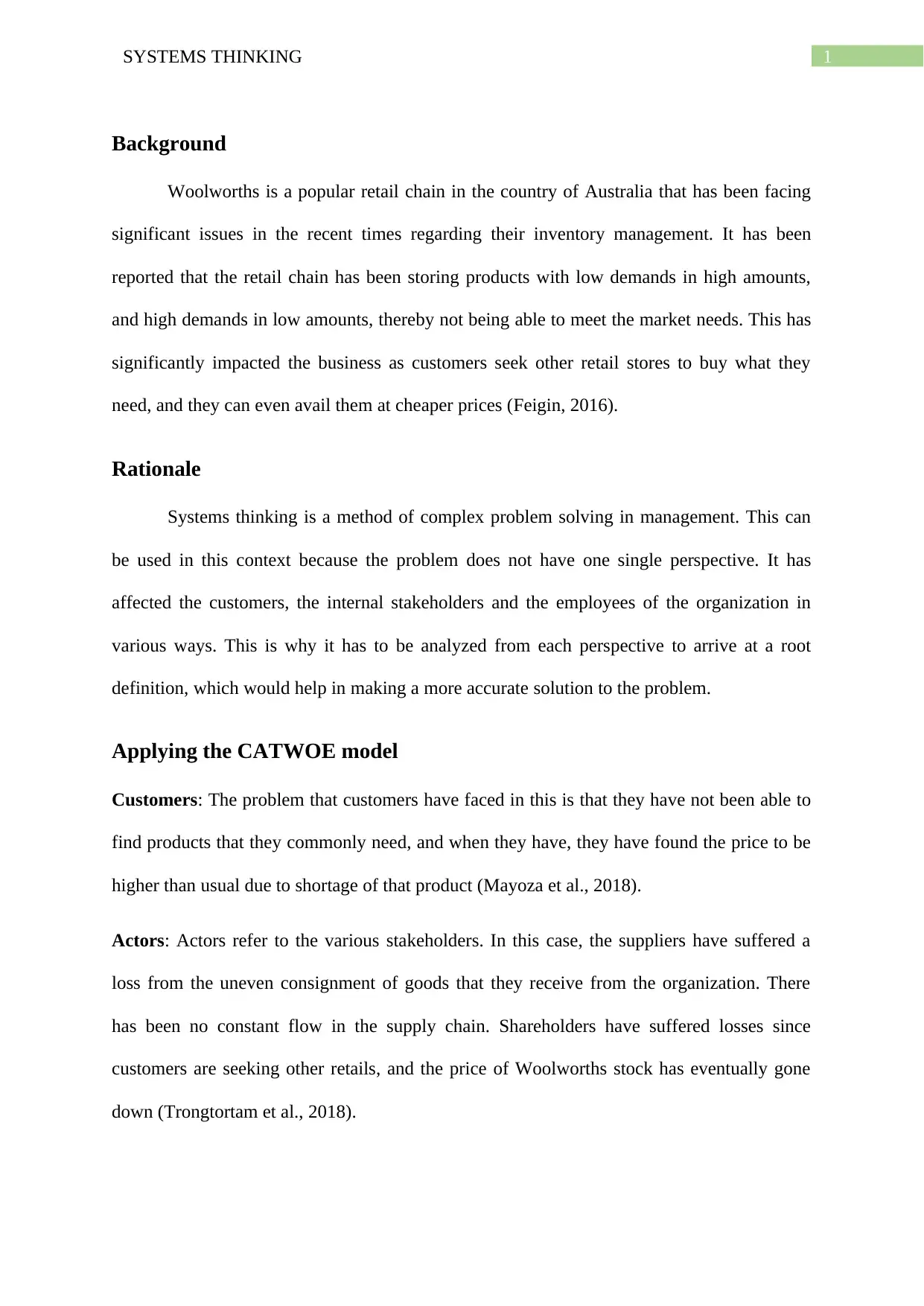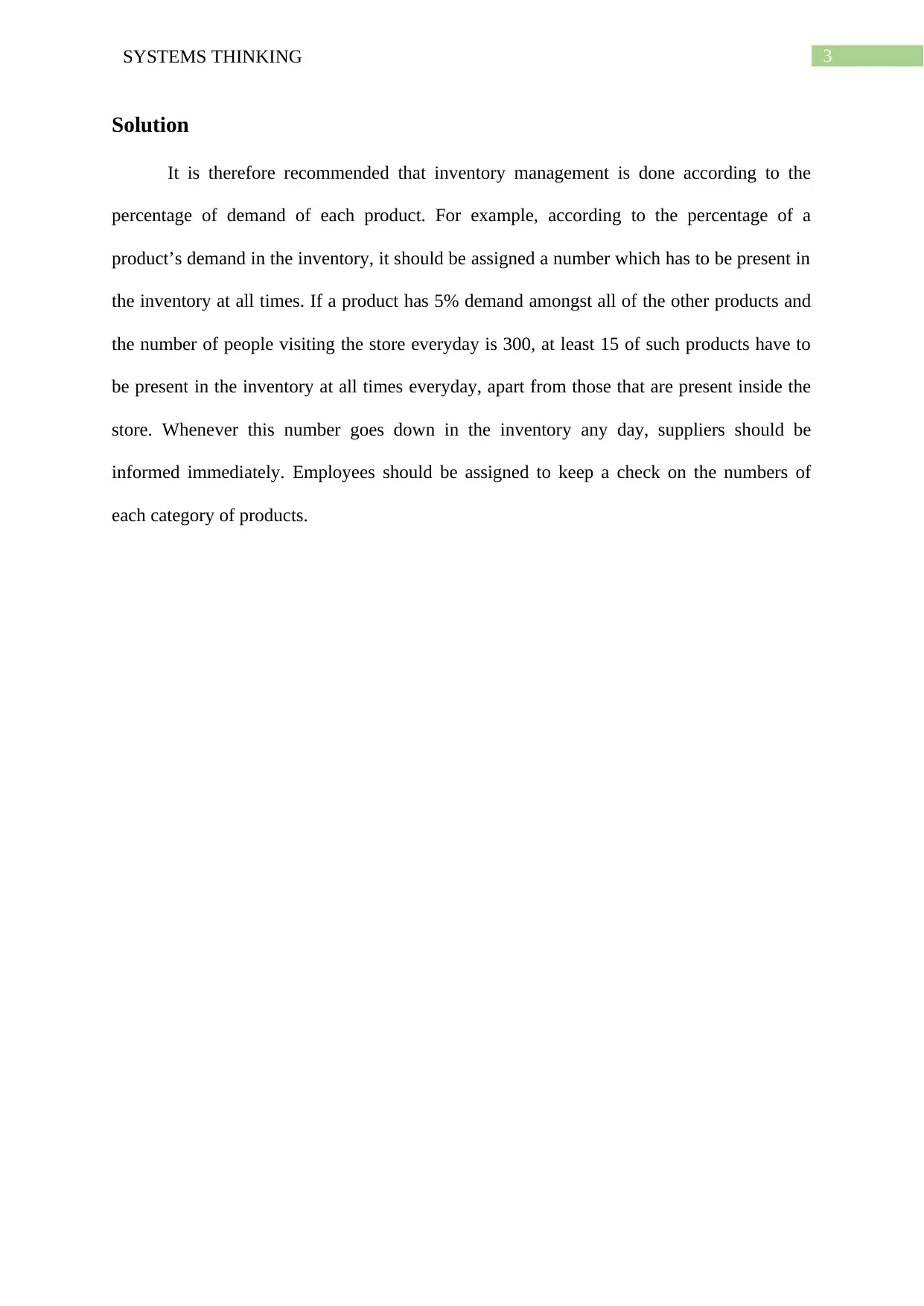MGT603 - Systems Thinking: Analyzing Woolworths Inventory Challenges
VerifiedAdded on 2022/11/27
|5
|1053
|485
Report
AI Summary
This report provides a systems thinking analysis of Woolworths' inventory management problems. It begins by outlining the issues, including overstocking of low-demand products and shortages of high-demand items, which leads to customer dissatisfaction and financial losses. The report applies the C...

Running head: SYSTEMS THINKING
SYSTEMS THINKING
Name of the Student:
Name of the University:
Author Note:
SYSTEMS THINKING
Name of the Student:
Name of the University:
Author Note:
Paraphrase This Document
Need a fresh take? Get an instant paraphrase of this document with our AI Paraphraser

1SYSTEMS THINKING
Background
Woolworths is a popular retail chain in the country of Australia that has been facing
significant issues in the recent times regarding their inventory management. It has been
reported that the retail chain has been storing products with low demands in high amounts,
and high demands in low amounts, thereby not being able to meet the market needs. This has
significantly impacted the business as customers seek other retail stores to buy what they
need, and they can even avail them at cheaper prices (Feigin, 2016).
Rationale
Systems thinking is a method of complex problem solving in management. This can
be used in this context because the problem does not have one single perspective. It has
affected the customers, the internal stakeholders and the employees of the organization in
various ways. This is why it has to be analyzed from each perspective to arrive at a root
definition, which would help in making a more accurate solution to the problem.
Applying the CATWOE model
Customers: The problem that customers have faced in this is that they have not been able to
find products that they commonly need, and when they have, they have found the price to be
higher than usual due to shortage of that product (Mayoza et al., 2018).
Actors: Actors refer to the various stakeholders. In this case, the suppliers have suffered a
loss from the uneven consignment of goods that they receive from the organization. There
has been no constant flow in the supply chain. Shareholders have suffered losses since
customers are seeking other retails, and the price of Woolworths stock has eventually gone
down (Trongtortam et al., 2018).
Background
Woolworths is a popular retail chain in the country of Australia that has been facing
significant issues in the recent times regarding their inventory management. It has been
reported that the retail chain has been storing products with low demands in high amounts,
and high demands in low amounts, thereby not being able to meet the market needs. This has
significantly impacted the business as customers seek other retail stores to buy what they
need, and they can even avail them at cheaper prices (Feigin, 2016).
Rationale
Systems thinking is a method of complex problem solving in management. This can
be used in this context because the problem does not have one single perspective. It has
affected the customers, the internal stakeholders and the employees of the organization in
various ways. This is why it has to be analyzed from each perspective to arrive at a root
definition, which would help in making a more accurate solution to the problem.
Applying the CATWOE model
Customers: The problem that customers have faced in this is that they have not been able to
find products that they commonly need, and when they have, they have found the price to be
higher than usual due to shortage of that product (Mayoza et al., 2018).
Actors: Actors refer to the various stakeholders. In this case, the suppliers have suffered a
loss from the uneven consignment of goods that they receive from the organization. There
has been no constant flow in the supply chain. Shareholders have suffered losses since
customers are seeking other retails, and the price of Woolworths stock has eventually gone
down (Trongtortam et al., 2018).

2SYSTEMS THINKING
Transformation process: The retail change keeps a track of the goods outflow, counts the
number of each good in the inventory and accordingly orders for the materials from the
suppliers (Indahati, Fitriani & Munajat, 2017).
Worldview: Gradually, this poor inventory management has been leading to a disrupted
market dynamics. There are specific needs in the market, which the company has not been
able to address, which has led to customers not finding their required materials, and the prices
of common goods have gone up, making them shift to other retail chains (Mahalepa &
Goede, 2018).
Owners: The decision makers have to do something in this regard since the organization
might soon collapse. The stock and profitability have already gone down due to customers
switching to other chains, and in this way, the organization would not be able to sustain itself
(Trongtortam et al., 2018).
Environmental constraint: There is no specific environmental constraint that could be
identified in this issue. It is an internal fault of the management as they cannot manage the
inventory properly.
Root definition
Woolworths Australia have been facing a severe issue with inventory management,
storing products with low demands in high amounts, and high demands in low amounts. This
has made the customers unable to find the common products they look for and if they do, it is
at a higher price. As a result, they have been shifting to other retails, impacting the stock
prices of the organization. Suppliers have suffered from uneven consignment of goods. It is
not aligned with the market dynamics and if this continues, the organization would not be
able to sustain itself.
Transformation process: The retail change keeps a track of the goods outflow, counts the
number of each good in the inventory and accordingly orders for the materials from the
suppliers (Indahati, Fitriani & Munajat, 2017).
Worldview: Gradually, this poor inventory management has been leading to a disrupted
market dynamics. There are specific needs in the market, which the company has not been
able to address, which has led to customers not finding their required materials, and the prices
of common goods have gone up, making them shift to other retail chains (Mahalepa &
Goede, 2018).
Owners: The decision makers have to do something in this regard since the organization
might soon collapse. The stock and profitability have already gone down due to customers
switching to other chains, and in this way, the organization would not be able to sustain itself
(Trongtortam et al., 2018).
Environmental constraint: There is no specific environmental constraint that could be
identified in this issue. It is an internal fault of the management as they cannot manage the
inventory properly.
Root definition
Woolworths Australia have been facing a severe issue with inventory management,
storing products with low demands in high amounts, and high demands in low amounts. This
has made the customers unable to find the common products they look for and if they do, it is
at a higher price. As a result, they have been shifting to other retails, impacting the stock
prices of the organization. Suppliers have suffered from uneven consignment of goods. It is
not aligned with the market dynamics and if this continues, the organization would not be
able to sustain itself.
⊘ This is a preview!⊘
Do you want full access?
Subscribe today to unlock all pages.

Trusted by 1+ million students worldwide

3SYSTEMS THINKING
Solution
It is therefore recommended that inventory management is done according to the
percentage of demand of each product. For example, according to the percentage of a
product’s demand in the inventory, it should be assigned a number which has to be present in
the inventory at all times. If a product has 5% demand amongst all of the other products and
the number of people visiting the store everyday is 300, at least 15 of such products have to
be present in the inventory at all times everyday, apart from those that are present inside the
store. Whenever this number goes down in the inventory any day, suppliers should be
informed immediately. Employees should be assigned to keep a check on the numbers of
each category of products.
Solution
It is therefore recommended that inventory management is done according to the
percentage of demand of each product. For example, according to the percentage of a
product’s demand in the inventory, it should be assigned a number which has to be present in
the inventory at all times. If a product has 5% demand amongst all of the other products and
the number of people visiting the store everyday is 300, at least 15 of such products have to
be present in the inventory at all times everyday, apart from those that are present inside the
store. Whenever this number goes down in the inventory any day, suppliers should be
informed immediately. Employees should be assigned to keep a check on the numbers of
each category of products.
Paraphrase This Document
Need a fresh take? Get an instant paraphrase of this document with our AI Paraphraser

4SYSTEMS THINKING
REFERENCES
Feigin, L. M. (2016). The effects of protests and boycotts on a brand and its reputation: a
case study on Woolworths and boycott, divestment and sanctions (BDS) (Doctoral
dissertation, The IIE).
Indahati, P., Fitriani, R. N., & Munajat, Q. (2017). Knowledge Management System Features
Analysis Using Soft System Methodology: A Case Study of an Agency in the
Ministry of Religious Affairs in Indonesia. Journal of Engineering and Applied
Sciences, 12(12), 3277-3280.
Mahalepa, T., & Goede, R. (2018, January). INDUSTRY NEEDS FOR DATA
WAREHOUSING STUDENTS: USING SSM AS HERMENEUTIC DATA
ANALYSIS TOOL FOR INTERPRETIVE INTERVIEW DATA. In Proceedings of
the 61st Annual Meeting of the ISSS-2017 Vienna, Austria (Vol. 2017, No. 1).
Mayoza, L., Agus, A., Lili, W., & Rizal, A. (2018). ANALYTICAL BUSINESS
DEVELOPMENT ON NEON TETRA (PARACHEIRODON INNESI)
ORNAMENTAL FISH CULTIVATION. GSJ, 6(7), 938.
Trongtortam, S., Francis, H., Taylor, M., Sudirman, S., & Symons, A. (2018, September).
Development of a Preliminary Model Guide for Using Mobile Learning Technology
in Resource–Limited Primary Schools in Thailand. In 2018 11th International
Conference on Developments in eSystems Engineering (DeSE) (pp. 83-88). IEEE.
REFERENCES
Feigin, L. M. (2016). The effects of protests and boycotts on a brand and its reputation: a
case study on Woolworths and boycott, divestment and sanctions (BDS) (Doctoral
dissertation, The IIE).
Indahati, P., Fitriani, R. N., & Munajat, Q. (2017). Knowledge Management System Features
Analysis Using Soft System Methodology: A Case Study of an Agency in the
Ministry of Religious Affairs in Indonesia. Journal of Engineering and Applied
Sciences, 12(12), 3277-3280.
Mahalepa, T., & Goede, R. (2018, January). INDUSTRY NEEDS FOR DATA
WAREHOUSING STUDENTS: USING SSM AS HERMENEUTIC DATA
ANALYSIS TOOL FOR INTERPRETIVE INTERVIEW DATA. In Proceedings of
the 61st Annual Meeting of the ISSS-2017 Vienna, Austria (Vol. 2017, No. 1).
Mayoza, L., Agus, A., Lili, W., & Rizal, A. (2018). ANALYTICAL BUSINESS
DEVELOPMENT ON NEON TETRA (PARACHEIRODON INNESI)
ORNAMENTAL FISH CULTIVATION. GSJ, 6(7), 938.
Trongtortam, S., Francis, H., Taylor, M., Sudirman, S., & Symons, A. (2018, September).
Development of a Preliminary Model Guide for Using Mobile Learning Technology
in Resource–Limited Primary Schools in Thailand. In 2018 11th International
Conference on Developments in eSystems Engineering (DeSE) (pp. 83-88). IEEE.
1 out of 5
Related Documents
Your All-in-One AI-Powered Toolkit for Academic Success.
+13062052269
info@desklib.com
Available 24*7 on WhatsApp / Email
![[object Object]](/_next/static/media/star-bottom.7253800d.svg)
Unlock your academic potential
© 2024 | Zucol Services PVT LTD | All rights reserved.





